|
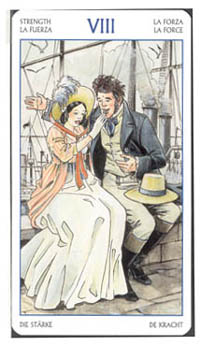 On several occasions I have pointed out that the small booklets which usually come with the tarot
decks from Lo Scarabeo (and other mass market publishers) for the most part, are rather inferior
and do not say much about the actual deck. With the Jane Austen Tarot we have quite a different
situation. A 174 page book accompanies the deck, besides the usual multi-language booklet with
about 10 page descriptions (in each language). I'll rather say, that this is a book with an
accompanying deck. Who comes first, the chicken or the egg? In this case the book is the main
concept and the deck is a set of loose leaf illustrations for the book. Diane Wilkes, the author,
came up with the Jane Austen Tarot concept about 5 years ago and offered it to Lo Scarabeo to be
published as a book/deck set. She wrote the book and Lo Scarabeo assigned an illustrator,
Lola Airaghi, to create the art. The back cover of the book mentions that Ms. Airaghi has illustrated
several comic books with historical settings and that she had achieved the prestigious "Yellow Kid-
Award" as the best Italian artist of 2005. That's something, or is it?
On several occasions I have pointed out that the small booklets which usually come with the tarot
decks from Lo Scarabeo (and other mass market publishers) for the most part, are rather inferior
and do not say much about the actual deck. With the Jane Austen Tarot we have quite a different
situation. A 174 page book accompanies the deck, besides the usual multi-language booklet with
about 10 page descriptions (in each language). I'll rather say, that this is a book with an
accompanying deck. Who comes first, the chicken or the egg? In this case the book is the main
concept and the deck is a set of loose leaf illustrations for the book. Diane Wilkes, the author,
came up with the Jane Austen Tarot concept about 5 years ago and offered it to Lo Scarabeo to be
published as a book/deck set. She wrote the book and Lo Scarabeo assigned an illustrator,
Lola Airaghi, to create the art. The back cover of the book mentions that Ms. Airaghi has illustrated
several comic books with historical settings and that she had achieved the prestigious "Yellow Kid-
Award" as the best Italian artist of 2005. That's something, or is it?
Diane Wilkes is a well-known tarotist, who for several years has been the owner and webmistress of
"tarotpassages.com"
. A website, which took pride in documenting and reviewing every tarot deck
and book that appeared worldwide from the late 1990's and onwards. An issue she admirably took care
of until about a year ago when, I assume, the work on the "Jane Austen Tarot" regrettably took her
energy away from updating her site; a break it will be difficult to catch up with.
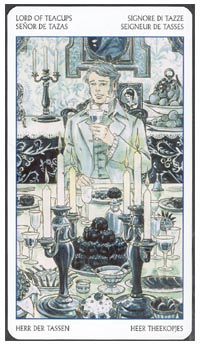 I'm sure that Diane Wilkes may have written a perfect book about the 17th-18th century author
Jane Austen and her literary works. Wilkes' knowledge of the subject is top notch. The problem is,
that a devoted tarotist like her, and so many others with her, have this absurd idea, that everything
shall necessarily be fitted into a tarot structure, where it doesn't belong.
I'm sure that Diane Wilkes may have written a perfect book about the 17th-18th century author
Jane Austen and her literary works. Wilkes' knowledge of the subject is top notch. The problem is,
that a devoted tarotist like her, and so many others with her, have this absurd idea, that everything
shall necessarily be fitted into a tarot structure, where it doesn't belong.
I have to admit that my knowledge of Jane Austen is as minimal as it can be. I have probably read
one or two of her books in my youth (and that is many years ago) and I have also seen one or two of
the films made after her books, without any of them having made any lasting impression on me. To say
it frankly, family novels and costume films made over a literary concept bore me. To take a novel,
cut it into pieces to make a film manuscript and then follow the script, has in my opinion not much
to do with the medium of film. To cut up seven novels to fit into a tarot structure is not that
much better. So I am probably not the right one to write this review. But who else will do it for
this forum?
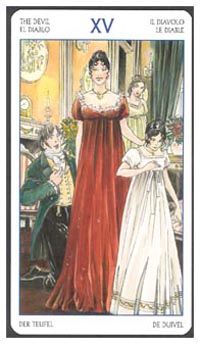 I did hope that the book could give me a survey of the life and doings of Jane Austen. A
comprehensive introductory chapter about the person and author Jane Austen and her life and work,
but it didn't. As the ignorant person I am, I did not even know where in historic times I could
find her. So I looked in the book to find out when Austen lived. But in vain. Luckily, that
information was given on the ten pages in the LWB - the little white booklet - which is boxed
with the deck - but not in the 174 page book itself. Thanks to the LWB, I learned that Austen
was born in 1775 and that she wrote her most famous books in her early twenties and that her last
book was published in 1818 after her early death. That means that Austen's novels were written
about 100 years before tarot reached Great Britain.
I did hope that the book could give me a survey of the life and doings of Jane Austen. A
comprehensive introductory chapter about the person and author Jane Austen and her life and work,
but it didn't. As the ignorant person I am, I did not even know where in historic times I could
find her. So I looked in the book to find out when Austen lived. But in vain. Luckily, that
information was given on the ten pages in the LWB - the little white booklet - which is boxed
with the deck - but not in the 174 page book itself. Thanks to the LWB, I learned that Austen
was born in 1775 and that she wrote her most famous books in her early twenties and that her last
book was published in 1818 after her early death. That means that Austen's novels were written
about 100 years before tarot reached Great Britain.
In her introduction, Wilkes states "...one might think that the writings of Jane Austen would not
mesh particularly well with the occult nature of the tarot..." and gives herself the answer, that
what they have in common is their identical message: the importance of balance in our everyday
lives..." In my opinion, tarot decks of this sort have not much, if anything, to do with
"the occult nature of tarot" and neither are they intended to.
Without doubt, Diane Wilkes knows her Jane Austen by heart (she has, btw, a Masters Degree in
English). The main concept for the Jane Austen Tarot is, that she collected passages spread
over seven of Austen's major works, which more or less fit in with the 78 tarot card's
traditional interpretation. This scenery and/or quotes were then used as a basis for the
illustrator's task.
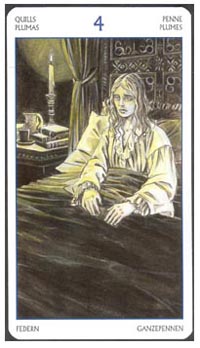 In several ways the author takes it as a matter of course that the buyers are familiar with
the works of Austen, which I do not believe they are in general. The only knowledge about the
literary background for the deck is presented in an appendix as short synopses of the seven books.
From ½ to 2 pages for each book, which all are large works. That's not enough to place the reader
with no earlier knowledge of Austen's works into a right 17-18th century upper class environment.
In several ways the author takes it as a matter of course that the buyers are familiar with
the works of Austen, which I do not believe they are in general. The only knowledge about the
literary background for the deck is presented in an appendix as short synopses of the seven books.
From ½ to 2 pages for each book, which all are large works. That's not enough to place the reader
with no earlier knowledge of Austen's works into a right 17-18th century upper class environment.
In each of the 78 card descriptions of two pages each, there are four sections: 1) card
description: what scene from one of the books does this card depict, 2) storyline: what
happens in Austen's book, 3) card interpretation: how can this scene/this illustration be
explained and 4) what would Jane do, i.e. what advice could we expect to hear from Jane Austen
in this situation?
The four minor arcana suits are: Quills (rationalism, intellectualism and analytic matters),
Teacups (love and emotion), Candlesticks (passion, energy and initiative) and Coins (physical
and tangible matters). Suitmarks presumably chosen because they reflect life in the late 18th and
early 19th century (imagine those voluminous Austen-novels written by candlelight using a quill
while drinking tea!) With these suitmarks we come to a problem. In any given suit of fourteen minor
arcana cards, the suitmark (being it cups or teacups) should ideally be rendered 59 times. At least,
the suitmark should be shown one time on each card and, as far as the number cards are concerned,
be supported by a digit to make it clear, which card it actually is. I have several times earlier
pointed to this shortcoming in many modern tarot decks, but for some reason, I took a closer look
here at the remarkable "suit of teacups". Where are the teacups? Only nine teacups are visible in
this suit. Where have they all gone? Well, I found two of them on the "Two of Coins" but that was
all. Looking at the suit of candlesticks, there were nine total of them in that suit. On the other
hand, the suit of teacups depicts not less that seventeen candlesticks. Confused? I am. Did no
one tell the illustrator, what the idea with the suitmarks are? In my eyes, the illustrations
are in general rather boring, reminding me of the drawings which illustrated "doctors and nurses"
stories in long ago obsolete ladies weekly magazines. When is Lo Scarabeo going to use artists
and not comic book illustrators for their tarot decks?
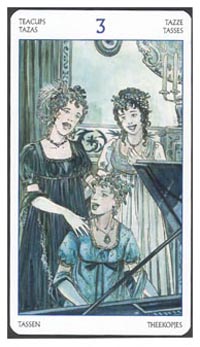 I have mixed feelings about tarot decks like this. Assuming it is intended as a card reading device,
which most modern tarot decks are, you certainly have to know your Austen (like Wilkes does) if
the Jane Austen Tarot shall be of any use. How many have that knowledge and can use it in this way?
Seeing it as a work about Jane Austen and her authorship, it does not tell much to the uninitiated
Austen fan.
I have mixed feelings about tarot decks like this. Assuming it is intended as a card reading device,
which most modern tarot decks are, you certainly have to know your Austen (like Wilkes does) if
the Jane Austen Tarot shall be of any use. How many have that knowledge and can use it in this way?
Seeing it as a work about Jane Austen and her authorship, it does not tell much to the uninitiated
Austen fan.
On the other hand, I do not doubt the deck will be a success. We are right now in a Jane Austen revival period, where her books are selling well, where Austen merchandise can be found everywhere.
A fact which Wilkes couldn't have been aware of 5 years ago. when this project was started.
There are a couple of questions I would have liked to have answered: 1) is the author pleased
with the illustrations? and 2) how would Austen have felt being pressed into a tarot-form?
|